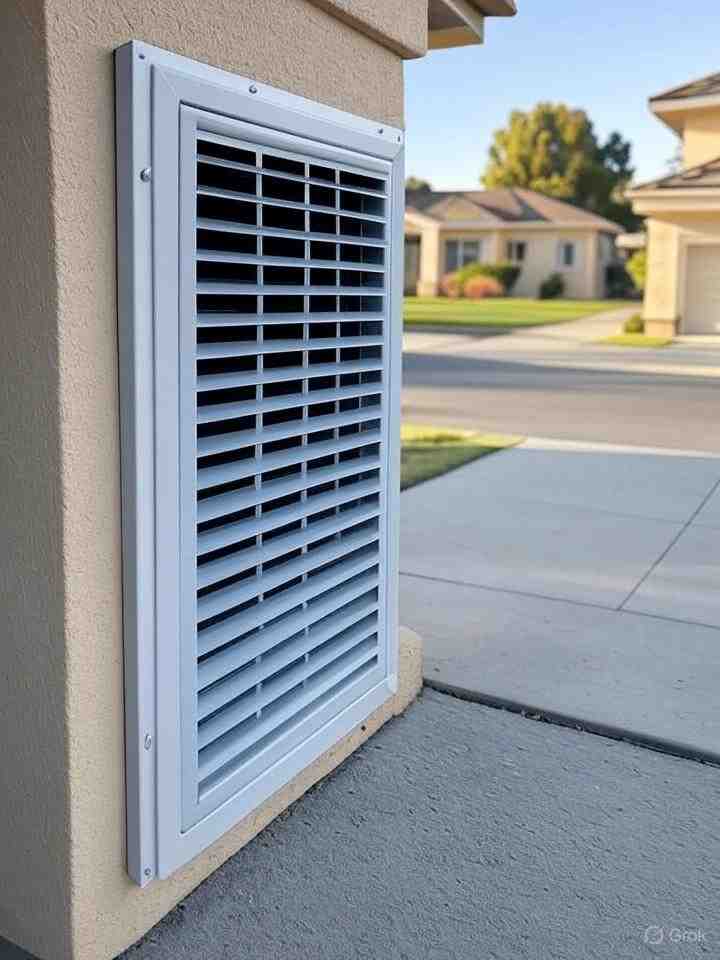


Protect your home with expert Clovis Dryer Vent Cover Replacement. Prevent clogs, boost airflow, and ensure safe, efficient dryer performance.
You’d be surprised how often a simple dryer vent cover can cause big problems. Most people don’t think about it until the dryer stops drying properly, or the laundry room starts smelling musty. The truth is, your dryer vent cover has a big job—it keeps pests out, lets air escape safely, and helps your dryer run like it should. But over time, things go wrong. From cracks and clogs to poor seals or even wildlife making it their new home, there are plenty of reasons homeowners in Clovis end up needing a replacement. That’s where Clovis Dryer Vent Cover Replacement comes in.
Plastic doesn’t last forever—especially not in Clovis heat. Many vent covers are made from lightweight plastic that becomes brittle over time. Between sun exposure, temperature swings, and general wear, the slats (called louvers) can crack or break off completely. Once that happens, you’re dealing with more than just looks.
Common Visual Signs:
| Problem | What You’ll See | Why It’s Bad |
|---|---|---|
| Cracks | Fine lines or splits in plastic | Reduces seal, lets moisture and pests in |
| Missing Louvers | Gaps where slats used to be | Makes it easy for animals to enter |
| Discoloration | Yellowing or chalky surface | Signs of UV damage and brittleness |
The worst part? These kinds of problems sneak up on you. You don’t notice them until your dryer isn’t drying or the house starts smelling weird. A routine peek at the vent cover from outside can save you a lot of stress later.
Here’s something a lot of people don’t realize: your dryer isn’t just drying your clothes. It’s pushing out warm, moist air through that vent. And if that air can’t get out—because of lint buildup, bird nests, or a jammed cover flap—you’re in trouble.
Your clothes take longer to dry. The dryer overheats. Your energy bill goes up. And worst-case scenario? You risk a dryer fire.
Quote to Remember:
“Neglected dryer vents are like clogged arteries—you won’t see the problem until it’s serious, but it was building up all along.”
That’s why pros always suggest cleaning the dryer vent regularly. But sometimes, it’s not just about cleaning. If the cover is too far gone—rusted shut, permanently stuck, or warped beyond repair—it’s time to replace it.
A functioning vent cover isn’t just there to look nice or keep bugs out. It plays a real role in home safety. Here’s how:
Prevents Carbon Monoxide Backflow: If you use a gas dryer, this one’s huge. A blocked or faulty vent can force exhaust gases back into your home.
Reduces Fire Risk: Lint is highly flammable. If it piles up around a jammed or closed vent cover, that heat from the dryer can ignite it.
Keeps Moisture Outside: Moisture stuck inside the vent can create mold, ruin drywall, or damage the dryer.
So even though it seems like a small piece of plastic or metal, the vent cover is part of your home’s bigger safety puzzle. If it’s not working right, the whole system is off.
| Problem Type | Risk Level | Average Replacement Cost |
|---|---|---|
| Cracked/Brittle Plastic | Low to Medium | $40–$100 |
| Animal Intrusion | High | $80–$200 (with cleanup) |
| Rusted Metal Flap | Medium | $60–$120 |
| Mold or Moisture Damage | High | Varies by damage |
| Emergency Service | Urgent | $100–$250 |
So yes, the part is cheap. But the cost of waiting too long? Not so cheap.
Q1: How often should I replace my dryer vent cover?
A: Most last 5–10 years, but it depends on material and exposure. If it’s cracked, rusted, or missing slats, replace it.
Q2: Can I just clean it instead of replacing it?
A: If it’s dirty but intact, yes. But if the flap sticks, the material is brittle, or pests got in—time for a new one.
Q3Is there a best material for vent covers?
A: Metal is durable but can rust. Plastic resists rust but becomes brittle. Some modern options are UV-resistant plastic or powder-coated metal for better longevity.
Conclusion: Don’t Ignore the Small Stuff
A dryer vent cover isn’t something flashy. You won’t be showing it off at your next BBQ. But it is something that protects your home, your clothes, and your wallet. Whether it’s broken louvers, bird nests, stuck flaps, or poor airflow, the problems usually start small—and then snowball.
